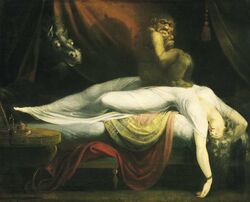Sleep paralysis: Difference between revisions
>Josikins No edit summary |
>Josikins No edit summary |
||
| Line 1: | Line 1: | ||
{{stub}}{{proofread}} | {{stub}}{{proofread}} | ||
[[File:John Henry Fuseli - The Nightmare.JPG|250px|thumbnail|''[http://en.wikipedia.org/wiki/The_Nightmare The Nightmare]'', by [http://en.wikipedia.org/wiki/Henry_Fuseli Henry Fuseli] (1781) is thought to be one of the classic depictions of sleep paralysis perceived as a demonic visitation.]] | [[File:John Henry Fuseli - The Nightmare.JPG|250px|thumbnail|''[http://en.wikipedia.org/wiki/The_Nightmare The Nightmare]'', by [http://en.wikipedia.org/wiki/Henry_Fuseli Henry Fuseli] (1781) is thought to be one of the classic depictions of sleep paralysis perceived as a demonic visitation.]] | ||
Sleep paralysis is a phenomenon that is distinctively separate from that of normal dreams. It can be defined as a state in which people, either when falling asleep or wakening, temporarily experience an inability to move which is often accompanied by hallucinations. More formally, it is a transition state between wakefulness and rest characterized by complete muscle atonia (muscle weakness). It can occur at sleep onset or upon awakening, and it is often associated with terrifying visions and [[external hallucinations]] (e.g., an intruder in the room or a demon sitting on one's chest), to which one is unable to react due to paralysis. It is believed a result of disrupted REM sleep, which is normally characterized by a complete loss of muscle control that prevents individuals from acting out their dreams. | '''Sleep paralysis''' is a phenomenon that is distinctively separate from that of normal dreams. It can be defined as a state in which people, either when falling asleep or wakening, temporarily experience an inability to move which is often accompanied by hallucinations. More formally, it is a transition state between wakefulness and rest characterized by complete muscle atonia (muscle weakness). It can occur at sleep onset or upon awakening, and it is often associated with terrifying visions and [[external hallucinations]] (e.g., an intruder in the room or a demon sitting on one's chest), to which one is unable to react due to paralysis. It is believed a result of disrupted REM sleep, which is normally characterized by a complete loss of muscle control that prevents individuals from acting out their dreams. | ||
Many people find sleep paralysis to be a horrific and negative experience but it can be escaped by simply changing the rhythm of one's breathing. When one changes their breathing pattern, such as holding one's breath or breathing much more deeply, if this is done for roughly 15 seconds or more the body will notice the change and automatically exit sleep paralysis. | Many people find sleep paralysis to be a horrific and negative experience but it can be escaped by simply changing the rhythm of one's breathing. When one changes their breathing pattern, such as holding one's breath or breathing much more deeply, if this is done for roughly 15 seconds or more the body will notice the change and automatically exit sleep paralysis. | ||
Revision as of 00:10, 23 June 2016
 |
This article is a stub. As such, it may contain incomplete or wrong information. You can help by expanding it. |

Sleep paralysis is a phenomenon that is distinctively separate from that of normal dreams. It can be defined as a state in which people, either when falling asleep or wakening, temporarily experience an inability to move which is often accompanied by hallucinations. More formally, it is a transition state between wakefulness and rest characterized by complete muscle atonia (muscle weakness). It can occur at sleep onset or upon awakening, and it is often associated with terrifying visions and external hallucinations (e.g., an intruder in the room or a demon sitting on one's chest), to which one is unable to react due to paralysis. It is believed a result of disrupted REM sleep, which is normally characterized by a complete loss of muscle control that prevents individuals from acting out their dreams.
Many people find sleep paralysis to be a horrific and negative experience but it can be escaped by simply changing the rhythm of one's breathing. When one changes their breathing pattern, such as holding one's breath or breathing much more deeply, if this is done for roughly 15 seconds or more the body will notice the change and automatically exit sleep paralysis.